
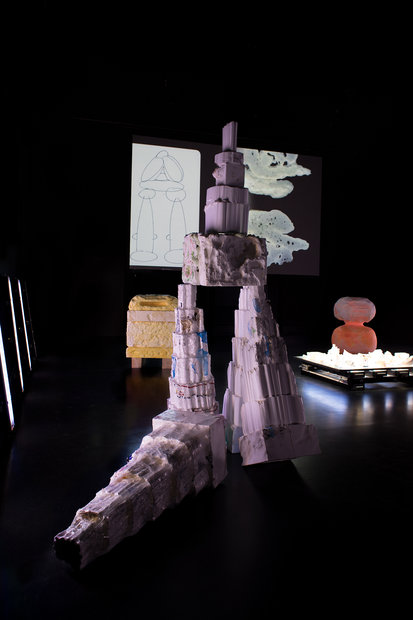
Installation view (© Jannis Zell)

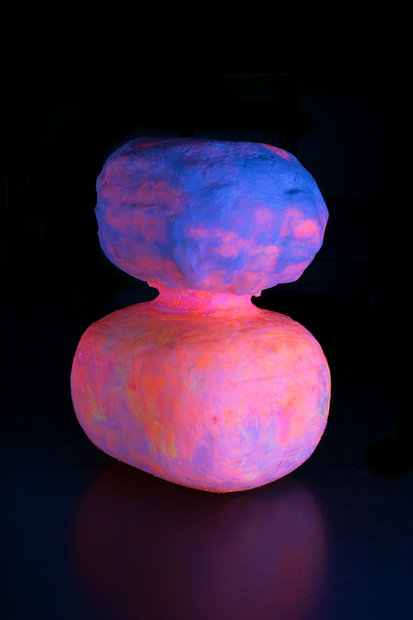
Statue of touch (© Jannis Zell)

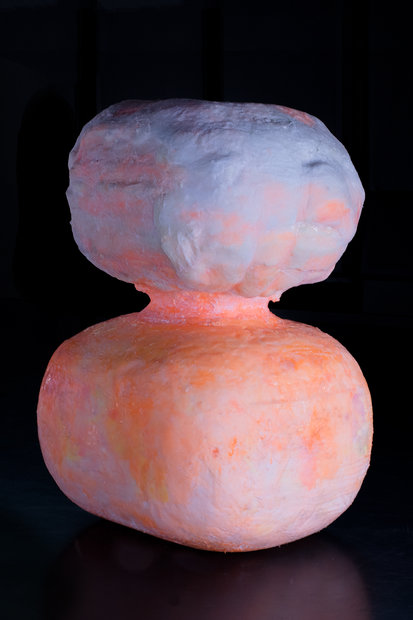
Statue of touch (© Jannis Zell)

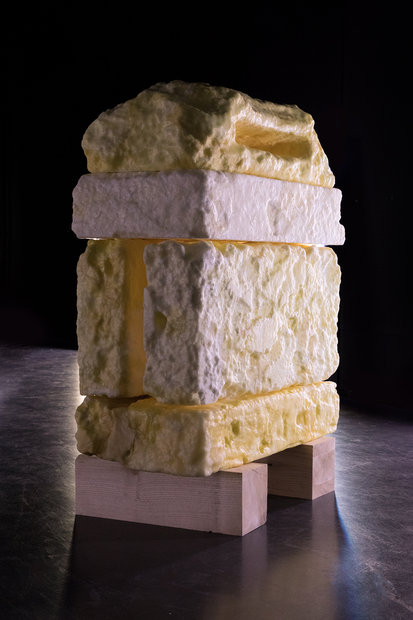
Cenotapht to the bees (© Jannis Zell)

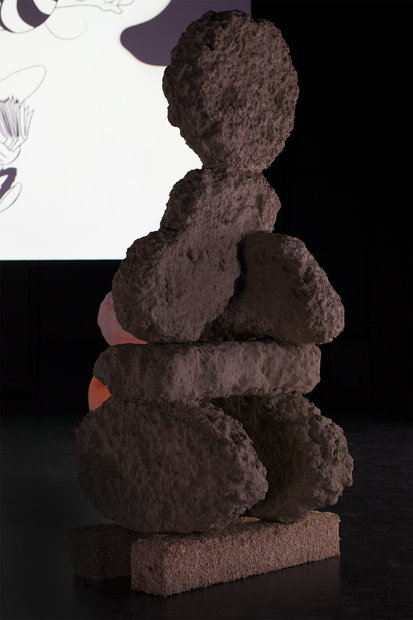
Chicken nuggets monolith (© Jannis Zell)


Well of true belief (© Jannis Zell)

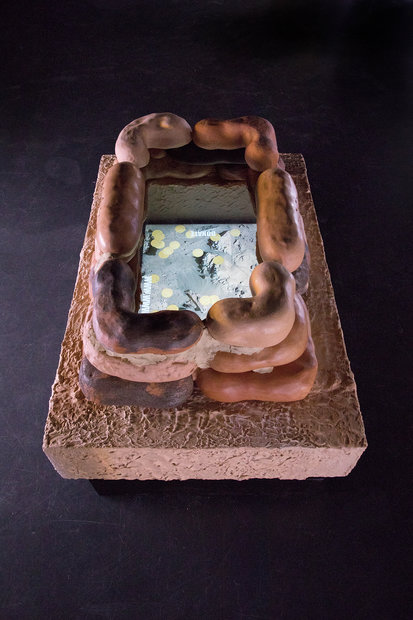
Well of true belief (© Jannis Zell)

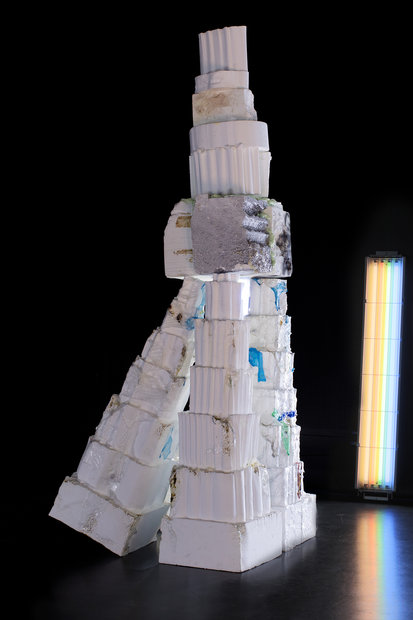
Plastic Palace (© Jannis Zell)


Screencap videoprojection (© Jannis Zell)

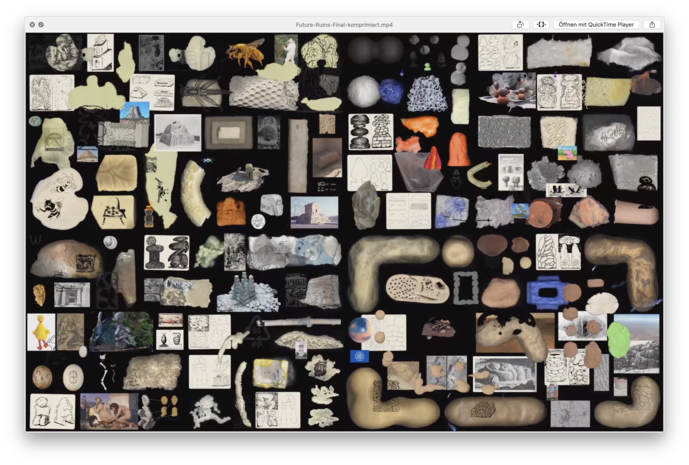
Screencap videoprojection (© Jannis Zell)


Screencap videoprojection (© Jannis Zell)

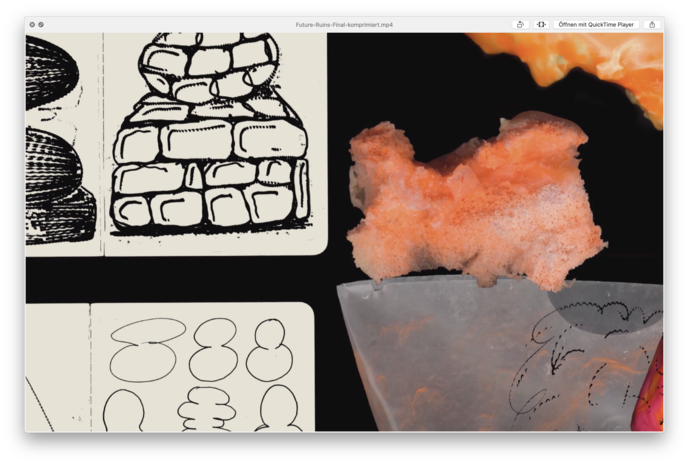
Screencap videoprojection (© Jannis Zell)

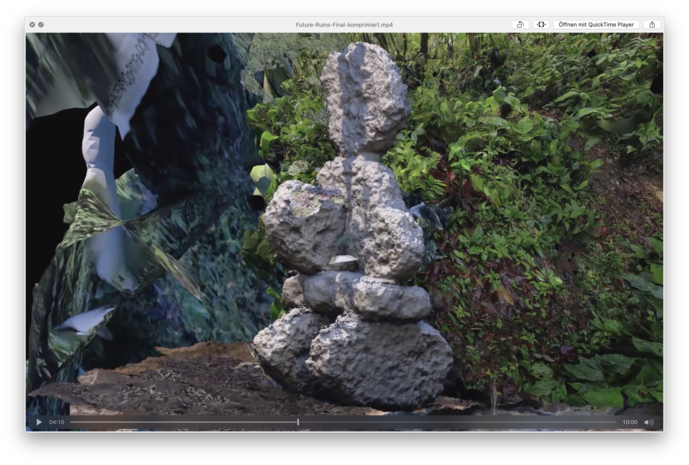
Screencap videoprojection (© Jannis Zell)


Screencap videoprojection (© Jannis Zell)

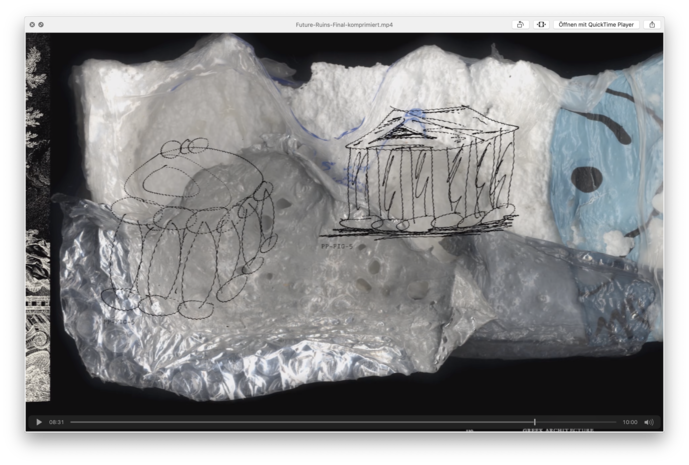
Screencap videoprojection (© Jannis Zell)
“Ash, black and desolate, stretched out on both sides of the road. Uneven heaps extended as far as the eye could see – the dim ruins of buildings, cities, a civilization – a corroded planet of debris, wind-whipped black particles of bone and steel and concrete mixed together in an aimless mortar.”
(Pay for the Printer, P. K. Dick, Satellite Science Fiction, 1955, LA.)
Future Ruins consists of five speculative monuments. These human-scaled models are dealing with current sociological and geological developments, the values and ideals of our time.
By definition, monuments only ever refer to the past. By creating monuments, for future scenarios, like the extinction of bees or the mining of plastics I am dealing with phenomena that are not part of a remembrance culture yet.
A sculpture made of chicken nuggets addresses the significant amount of chicken bones as future fossils. A wishing well asks for your Paypal-donation on Mars.
A silicone figure deals with the decreasing human interaction and physicality in a technological era. Five handcrafted sculptures form an incomplete list of the most pressing questions of our time.
As modern beings, we continuously think about our legacy, the traces we leave behind. How will future civilizations remember us? What story of our existence will extra-terrestrial species reconstruct from our fossilized traces on Earth? What debris will remain, while most of our digital artifacts disappear or blur into the pitch black cloud? What will be tomorrow’s gold and marble?
The exhibition serves as a stage for reflection on our present relationship with the planet we inhabit. Today, the winners of history can be found in the steles, statues, memorials and masonry that we pass in daily life. Within their seemingly undestroyable materiality they promise an existence, transcending the ravages of time. In our present society, the desire to conserve and protect places that are important to us appears to be typical human behaviour.
The five monuments were crafted by hand using traditional prop-making materials, leftovers and a range of components found in the hardware store. Silicone, plaster or plastic pieces form the skin on sculpted styrofoam bodies. The short-lived building material, like wax or mattress foam manifests a strong contrast to the long- lasting stone, marble and steel used for traditional monuments. How will value change over time? What will the monuments of a post-human future consist of? What will they tell us? What will they warn us about? What advices can they give us?
Exploring intuitive production methods and the neglection of industrial processing or tools led to unexpected results. Marbled scraps, shades of yellow, drops and blends. The production process remains visible.
A pool of personal drawings, collected imagery and artefacts was translated into spacial objects, altered, filtered and smoothed. The anachronistic sources of this morphology reach from prehistoric tombs to fascia rolls.
I found myself in the role of a manic post- apocalyptical sculptor. Small flakes of electrostatic styrofoam followed my every step. The acid smell of silicone wouldn’t leave my nostrils.
I am forging materials. Skeuomorphic staging props. Expectations of objects and their substance are being subverted. Big rugged chunks of stone like texture stacked on top of each other, struggling against gravity. Curved ceramic stones with unusual textures and silhouettes.
By translating it into illusive objects, I question the existence of the original image and its mode of production. To what extent is an image or object time-related? How does material influence the trust we put in them? What kinds of objects may serve to proclaim facts or truth.
Are the monuments about to collapse or in the process of being built? Are they from the past, the future or the present?
CENOTAPH TO THE BEES
“You will probably more than once have seen her fluttering about the bushes, in a deserted corner of your garden, without realising that you were carelessly watching the venerable ancestor to whom we probably owe most of our flowers and fruits (for it is actually estimated that more than a hundred thousand varieties of plants would disappear if the bees did not visit them), and possibly even our civilization, for in these mysteries all things intertwine.”
-The Life of the Bee, Maurice Maeterlinck, G. Allen, London, 1901
The Cenotaph to the Bees is a memorial commemorating all the extinct bees of the Earth. The wax makes it a temporary monument. It is fragile to touch and heat.
Model: 120 × 98 × 50 cm Styrofoam, bees wax, paraffin
CHICKEN NUGGET MONOLITH
“It usually takes millions of years for evolution to occur, but here it has taken just decades to produce a new form of animal that has the potential to become a marker species of the Anthropocene – and the enormous numbers of these chicken bones discarded worldwide means that we are producing a new kind of fossil for the future geological record.”
-Professor Jan Zalasiewicz, Professor of Palaeobiology, University of Leicester
We are living in the age of the chicken.
The time we spent on Earth will be marked by leftover chicken bones. It has been about 8000 years since humans domesticated the Red Jungle Fowl (Gallus Gallus) – The primary progenitor of the domestic chicken.
The mass of all 23 billion chickens living at any given time, is greater than that of all other avian species combined.
The Chicken Nugget Monolith worships the chicken. It is modelled after the most iconic form of industrially processed meat. Including all four subcategories of Chicken McNuggets: “Bone”, “Bell”, “Ball” and “Boot”.
Model: 195 × 75 × 85 cm Styrofoam, mix of mineral plaster, pigments
WELL OF TRUE BELIEF
“Although we live in a technologically advanced society, superstition is as widespread as it has ever been. Superstitions, are the natural result of several well-understood psychological processes, including our human sensitivity to coincidence, a penchant for developing rituals to fill time (to battle nerves, impatience, or both), our efforts to cope with uncertainty, the need for control, and more.”
-Believing in Magic: The Psychology of Superstition, Stuart A. Vyse.
The Well of True Belief is a digital wishing well. It is the first monument to have been erected on Mars. shifting boundaries between our bodies and the external world.
Now we wish for fog and drips and drops and puddles and for the red ground to get soaked. For bottles and showers and toilets and window cleaners and Coca Cola light with ice cubes; for swimming and soup and pools and fountains and wells.
Model: 60 × 126 × 83 cm Styrofoam, gypsum, clay, pigments
STATUE OF TOUCH
“The greatest sense in our body is our touch sense. It is probably the chief sense in the process of sleep and waking; it gives us our knowledge of depth or thickness and form; we feel, we love and hate, are touchy and are touched, through the touch corpuses of our skin.”
-The Stages of Human Life , J. Lionel Taylor, Dutton, NY, 1921
Swiping and scrolling over the mirroring black buzzing and blinking screens of our devices. Tapping, superliking, ghosting. Human interaction with their tools has changed. So has the way we interact with each other. At the same time the surfaces of the objects and architecture that surround us have become more and more frictionless and smooth. The Statue of Touch with its wrinkled bumpy skin raises questions on physicality versus technology.
Model: 130 × 95 × 90 cm Styrofoam, silicone, mattress foam
PLASTIC PALACE
“When the French writer Roland Barthes went to a plastics exhibition in the mid-1950s, he interpreted what he saw in mythical terms. Not only did these substances have “names of Greek shepherds (Polystyrene, Polyvinyl)”, but they were the products of a kind of alchemy: “the public waits in a long queue in order to witness the accomplishment of the magical operation par excellence: the transmutation of matter.”
-Excerpts from Roland Barthes, “Plastic”, Myths, 1957
Between 4.8 and 12.7 million tonnes of plastic enter the ocean each year, according to figures published in the journal Science in 2015.
In the meantime plastics have floated onto and sunken into all parts of the ocean. Microplastic waiting to be caught in nano-nets. Harvested pieces of red party cups, green and white straws, yellow bags and particles of the long gone PETE, HDP, V, LDPE, PS and OTHER make up the columns and halls of the Plastic Palace in reminiscence of the age of plastic.
Model: 60 × 126 × 83 cm Styrofoam, PU, PP, HDPE, PE, PET, EVA
CONCEPT AND REALISATION: Jannis Zell
AUDIO POST PRODUCTION Philippe Mainz
NARRATOR VOICE Fabian Reichle
CODE (WWW.WWWISH.CLICK) Nicholas Popovic
VIDEO EDITING Phil Zumbruch
TEXT EDITING Jandra Böttger Theresa Rößler Johanna Schäfer
POSTER PRINTING Stober GmbH, Karlsruhe
PAPER, TYPEFACE, EDITION Holmen TRND 2.0 & Pica, 300 pcs
USED AUDIO PIECES
Chris Watson - Vatnajokull
Chris Watson - Crucero La Joya
The Mini Adventures of Winnie the Pooh - Lullabee Chaos Angel - Silicone (ft. Cosmo Boy) Snapping sounds produced by the snapping shrimp, Courtesy of Paul Perkins, NUWC Engineering.
NOTE
Every effort has been made to trace copyright holders and to obtain their permission for the use of copyright material. I apologise for any errors or omissions and would be grateful if notified of any corrections that should be incorporated in future reprints of this documentation.
THANK YOU
Univerity of Arts and Design: Sereina Rothenberger, Rebecca Stephany, Michael Kryenbühl, Ivan Weiss, James Langdon, Yannick Nuss, Katharina Wahl, Volker Albus, Matthias Bruhn, Sebastian Schäfer, Alexander Knoppig, Tobias Keilbach, Matthias Mai, Susanne Schmitt, Susanne Trautnitz, Zaur Ahlimanov, Waldemar Schwab
For the generous support: Lisa Ertel, Felix Plachtzik, Maxim Weirich, Phil Zumbruch, Lukas Marstaller, Oliver Boualam, Marcel Strauß, Anne-Sophie Oberkrome, Philipp Schell, Christoph Hauf, Christof Hierholzer, Massimiliano Audretsch, Ute Zell, Martin Zell